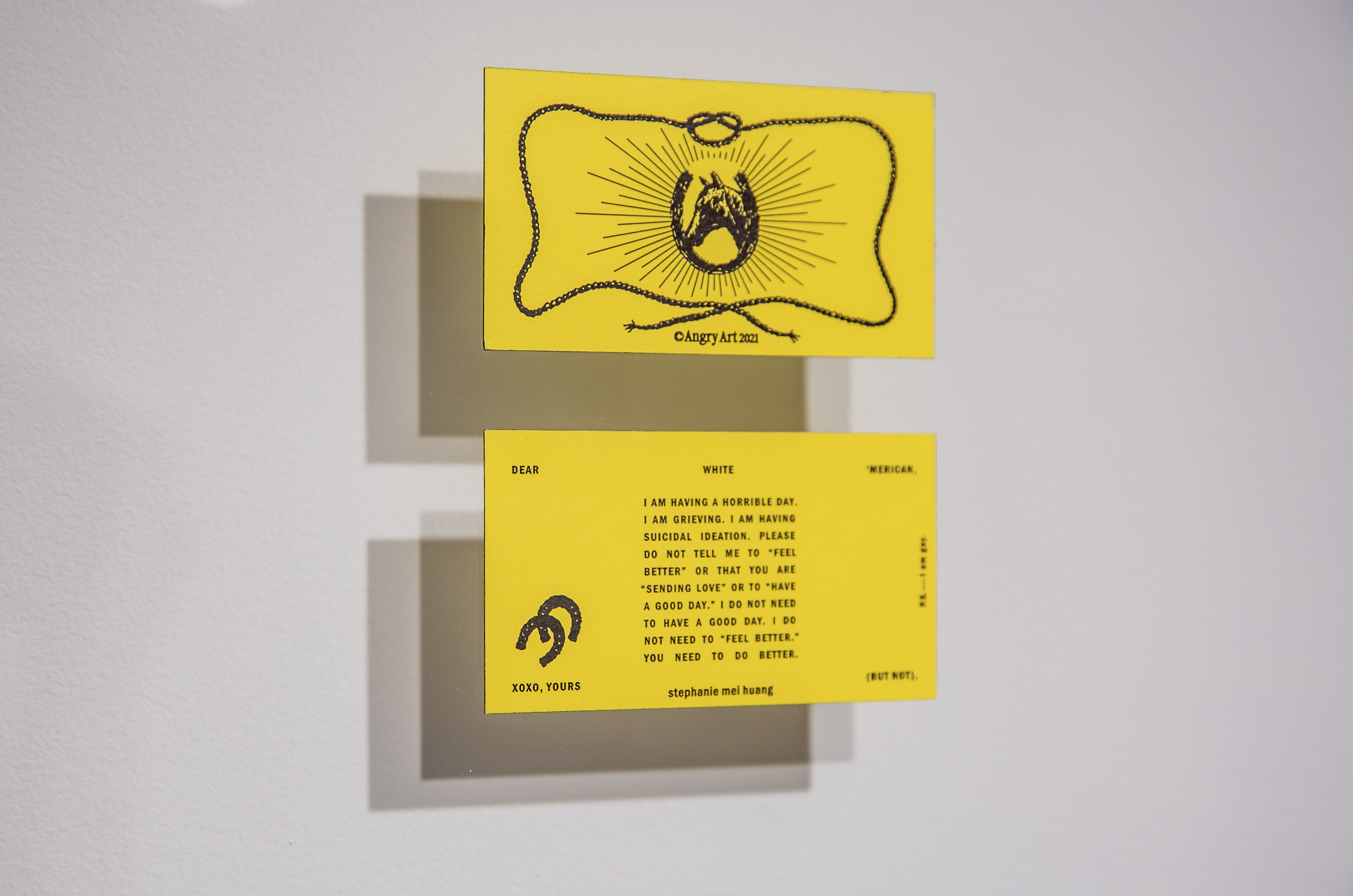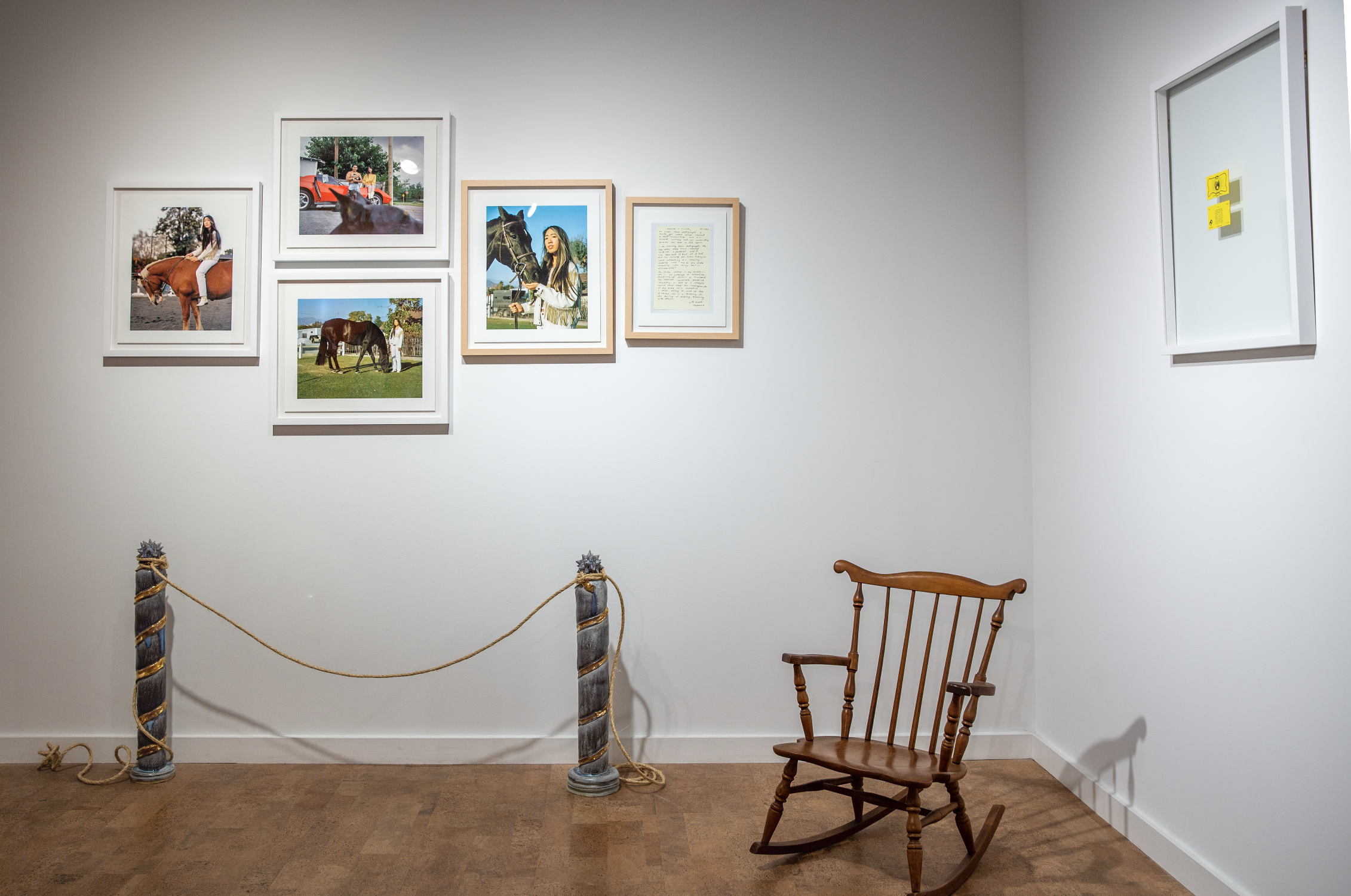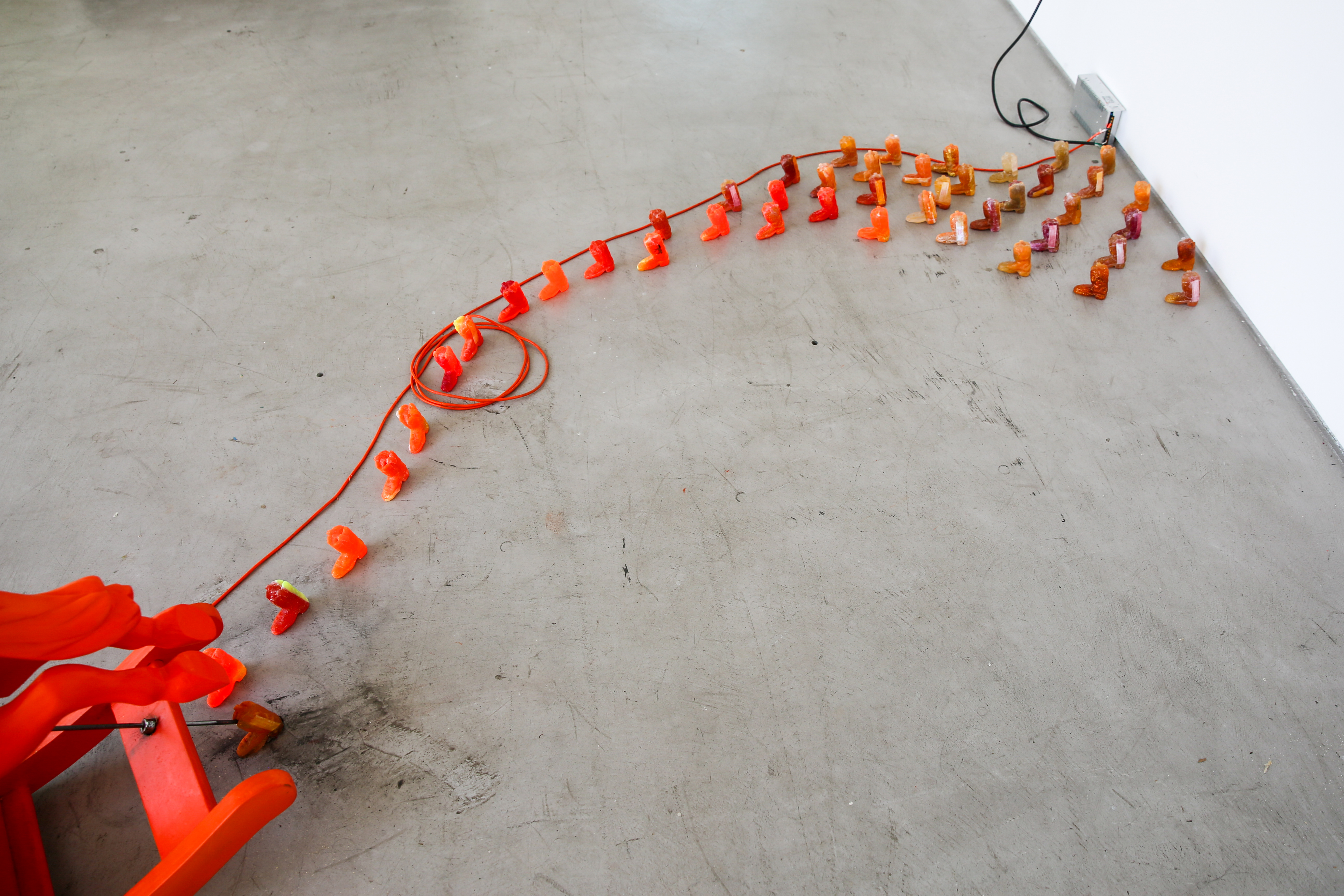how to hobble a young horse


PULPO GALLERY, Murnau am Staffelsee, 16 July - 28 August 2022
“That the domain of the animal is treated as a zone of deferral means that animality subtends a great deal below the white human man at the top, who in spite of his own superior position, can be dragged down by his own queer association.” - Mel Y. Chen, “Animacies: Biopolitics, Racial Mattering and Queer Afftect”
The horse has become imprecise. She is at once weaponized and abstracted as the symbol of the “free” and the “wild,” at once domesticated with a developed backbone to support human weight. She is at once simianized and anthropomorphized.


green requiem for myself iii
2022
oil on linen, sisal, horseshoes
how to hobble a young horse explores the
slippery terrains of animality, constraint,
and consent, in both taking on the figure of
the Chinese cowboy/girl and the horse in
the American (U.S.) West. huang shifts
animalities, in becoming them, rejecting
them, and transmuting them. The body of
work includes performance, film/video,
sculpture, painting and photography.2022
oil on linen, sisal, horseshoes

diamond
2022
animatronics horse
2022
animatronics horse

bay of hail Ii
2021
ceramic
![]()
copper elegy iii
2022
oil on canvas, silk, horse bit
![]()
copper elegy Iv
2022
oil on canvas, silk, horse bit
![]()
how to hobble a young horse (publication)
2022
TEXT BY stephanie mei huang, Clara Tang, Sonya Merutka, Arne de Boever and Allison C. Smith.
DESIGN & TYPOGRAPHY BY Christina Huang.
PHOTOGRAPHS OF WORK BY stephanie mei huang, Abe Heath and Andrew Siedenburg.
Digital Offset Printing
Foil Stamped Cover & Edge Painting
254 x 203 mm
136 pages
Printed in Germany
![]()
![]()
three of clubs i
2021
ceramic, gold
2021
ceramic

copper elegy iii
2022
oil on canvas, silk, horse bit

copper elegy Iv
2022
oil on canvas, silk, horse bit

how to hobble a young horse (publication)
2022
TEXT BY stephanie mei huang, Clara Tang, Sonya Merutka, Arne de Boever and Allison C. Smith.
DESIGN & TYPOGRAPHY BY Christina Huang.
PHOTOGRAPHS OF WORK BY stephanie mei huang, Abe Heath and Andrew Siedenburg.
Digital Offset Printing
Foil Stamped Cover & Edge Painting
254 x 203 mm
136 pages
Printed in Germany


three of clubs i
2021
ceramic, gold


how to hobble a young horse
2022
mini-dv converted to digital video, sound
2022
mini-dv converted to digital video, sound

green requiem for myself ii
2022
oil on linen, sisal, horseshoes
The exhibition is named after huang’s most recent performance, in which huang’s
cowboy avatar Stirrup Steph with her animatronic horse, Diamond, re-enacts and
distorts a found video tutorial of a cowboy demonstrating in disconcertingly
domineering and gendered language “how to hobble a young horse.” Stirrup Steph
inscribes themselves into the script in the way that they inscribe themselves into the
frontier of the American West, a mythological space they recognize as biopolitically,
historically, and thus, residually as not belonging to them. Through racial
melancholia, how do we navigate new conditions from which we speak and new ways
of inhabiting our subjectivities? How can we begin to consider melancholia as a
realistic and productive response to the insidious underbelly of American history?2022
oil on linen, sisal, horseshoes

lope studies i-iv
2022
mixed media
This eponymously titled exhibition self-animalizes while also re-animalizes and
suggests, at the shift away from Stirrup Steph, that huang is perhaps not a cowboy,
but a horse, or both. A carousel horse finds kinesis through a windshield wiper motor.
Stirrup Steph’s animatronics horse, Diamond, neighs if you pat her. A roping dummy
is topped with a ceramic ox/horse/dragon-head rather than a steer head. In taking on
different reimagined animalized subjectivities, Stirrup Steph acknowledges, plays
with, and reclaims the submissive drive of the cowboy and the American West.2022
mixed media



 copper elegy ii
copper elegy ii2022
oil on canvas, silk, horse bit

rope elegy i
2022
oil on canvas, silk, calf hobble



three of hearts, two of intents i
2021
ceramic

(self-portraits as) neither donkey nor horse
![]()
Hauser & Wirth, Los Angeles
Book & Printed Matter Lab
June 26 – August 1 2021
Curated by Allison C. Smith
The exhibition ‘(self-portraits as) neither donkey nor horse’, centers, celebrates, obscures para-narrativism and auto-theory: a critical practice deeply rooted in queer research and practice. It is through the vehicle of drag, self-portraiture and biography that huang erodes the violent mythologies that perpetuate expansionist, exceptionalist, and settler colonial narratives, while excavating forgotten, erased, and partial histories. ‘(self-portraits as) neither donkey nor horse’, while speaking to huang’s various and fractured avatarisms, prioritizes the narrative of Stirrup Steph— the youngest and first woman to be inaugurated into the Cowboy Artists of America (CAA), a brotherhood dedicated to conserving the culture and history of the old west.

bay of hail i (roping dummy), 2021
clay, found cattle tags, found ribbon, sisal, plastic, metal
clay, found cattle tags, found ribbon, sisal, plastic, metal
The tall and true tale of Stirrup Steph, and huang's splitting avatars, begs the question: could "cowboy drag," a form of racialized, gendered, affective drag, not unlike code-switching, an embodied passibility, provide a mimetic form of deception/self-preservation? Could it scramble systems of prediction projected upon huang’s body/identity? What are the alluring possibilities that result from racial melancholia: self-contradicting negotiations with pleasure and pain, multiple selves, identity/dis-identity formation?
In the wake of the 2021 Atlanta Spa Shootings, ‘(self-portraits as) neither donkey nor horse’ addresses biopolitical and xenophobic rhetoric that finds its roots in19th century “yellow peril” and is regurgitated/perpetuated in a 21st century anti-Chinese discourse surrounding Covid-19. huang’s work speaks to an urgency of visualizing melancholia and the exposure of grief— a melancholic fixation on that which excludes you: the implausibility of the Stirrup Steph.

e-lope
2021
video, sound

three of hearts, two of intents 三心二意 i
2021
clay

how are you (after adrian piper) ii, 2021
2021
Digital offset print
In collaboration with Christina Huang

how are you (after adrian piper) i, 2021
2021
Digital offset print
In collaboration with Nat Moonhill

how are you (after adrian piper) iii, 2021
2021
Digital offset print
In collaboration with Christina Huang

self portrait of three years of my life in Marfa, TX as the only full time East Asian resident
2018
In collaboration with Ada Smith
2018
In collaboration with Ada Smith

self portrait of three years of my life in Marfa, TX as the only full time East Asian resident ii
2018
In collaboration with Ada Smith
![]()
requiem for myself
2021
oil on linen, horseshoes, sisal
2018
In collaboration with Ada Smith

requiem for myself
2021
oil on linen, horseshoes, sisal



three of hearts, two of intents 三心二意 iii
2021
clay, sisal
2021
clay, sisal


neither donkey nor horse
neither donkery nor horse
2020
carousel horse, windshield wiper motor, resin, steel, oil paint, 12V power supply
2020
carousel horse, windshield wiper motor, resin, steel, oil paint, 12V power supply




how to paint a rocking horse
2020
VHS-C converted to digital, sound, carousel horse,
windshield wiper moto 12v power supply




white vegetable
white vegetable is a series of single-take 16mm films that explore the racially melancholic processes of fixation, ingestion, repulsion, and regurgitation. In Chinese, the direct translation for napa cabbage (baicai 白菜) is white vegetable. In Melancholy and Race, Anne Anlin Cheng remarks: “since the melancholic subject experiences resentment and denigration for the lost object with which he or she is identifying, the melancholic ends up administering to his or her own self-denigration.” She continues to elaborate that ìthe melancholic is not melancholic because he or she has lost something but because he or she has introjected that which he or she now reviles,” resulting in the melancholic “choking on...the hateful and loved thing he or she just devoured.”
white vegetable ii
2020
16mm transferred to digital
hyper(in)visibility
July 14, 2020
1:30-3:30 PDT
In conversation with Pearl C Hsiung, Maia Ruth Lee, Astria Suparak, Hồng-Ân Trương, and Christine Tien Wang, host stephanie mei huang invites all to hear from five Asian artists on reckoning with a racialized and gendered spectrum of visibility, moving through their practices with and of yellow embodiment, and the possibility of racial (or transgressively, non-racial) alternatives.
01:58 stephanie mei huang intro
07:27 stephanie mei huang presentation
13:35 panelists intro
16:11 Hồng-Ân Trương presentation
25:20 Maia Ruth Lee excerpt from film "The Stranger"
31:22 Christine Tien Wang presentation
37:56 Pearl C Hsiung presentation
44:35 Astria Suparak presentation
50:48 Round Table Discussion
1:21:49 Q&A
stephanie mei huang first proposed the panel to Contemporary Calgary on May 7th amidst the climate of COVID-19 and rise of anti-Asian xenophobia to discuss the yellow femme’s body, contagion, and virility from the perspective of Asian American artists. In the days and weeks that followed, internal crises at both VAG and Contemporary Calgary that were revealed publicly made the partnership untenable. To move forward with the panel given these crises would have decentered its original intentions, as the arts institutions were confronted with the urgency to examine systemic racism from within.
